 Download PDF
Download PDF
Name: Rubus allegheniensis Porter
Family: Rosaceae (the Rose family)
Common Names: Common Blackberry, Highbush Blackberry, Sow-teat Blackberry, Blackberry (1, 3, 4, 5, 6, 9).
 Etymology: Rubus means “bramble, blackberry, or raspberry” (10). Allegheniensis means “of the Allegheny Mountains” (2).
Etymology: Rubus means “bramble, blackberry, or raspberry” (10). Allegheniensis means “of the Allegheny Mountains” (2).
Botanical synonyms: Rubus nigrobaccus (16).
Quick Notable Features:
¬ Alternate, palmately compound 3-5 foliate leaves, green on both sides
¬ Many glands on the pedicels
¬ Stems bearing straight spines with broad, flat bases
Plant Height: The erect or high-arching plant is 1-3 m tall (2).
Subspecies/varieties recognized:
Rubus allegheniensis Porter var. albinus L.H. Bailey
Rubus allegheniensis Porter f. albinus Fernald
Rubus allegheniensis Porter var. nigrobaccus Farw.
Rubus allegheniensis Porter var. calycosus Fernald
Rubus allegheniensis Porter var. gravesii Fernald
Rubus allegheniensis Porter var. neoscoticus L.H Bailey
Rubus allegheninesis Porter var. plausus L.H. Bailey
Rubus allegheniensis Porter var. populifolius Fernald
Rubus allegheniensis Porter f. pugnax (L.H. Bailey) B. Boivin
Rubus allegheniensis Porter f. rubrobaccus L.P Wolfe & Hodgdon
Rubus allegheniensis Porter f. suffultus Fernald
Rubus allegheniensis Porter subvar. sativus Farw.
Rubus villosus var. montanus Porter (19,21)
Most Likely Confused with: Other members of Rubus such as R. occidentalis, R. flagellaris, R. hispidus, and R. pensilvanicus. Among scrambling and climbing plants, it might also be confused with Apios americana, Rosa setigera, and Rosa multiflora.
Habitat Preference: The species prefers woodland-borders, thickets, stream-valleys, clearings and fields, dry uplands, and many disturbed habitats such as roadsides and fencerows. It will occasionally grow in marshes and swamp-ground (1, 3, 5, 6, 7). It is known to grow in the mountains of North Carolina (9).
Geographic Distribution in Michigan: R. allegheniensis is found in over 60 counties in every region of the upper and lower peninsulas (14).
Known Elevational Distribution: R. allegheniensis was observed at altitudes of 1128 and 1158 m in Virginia (15).
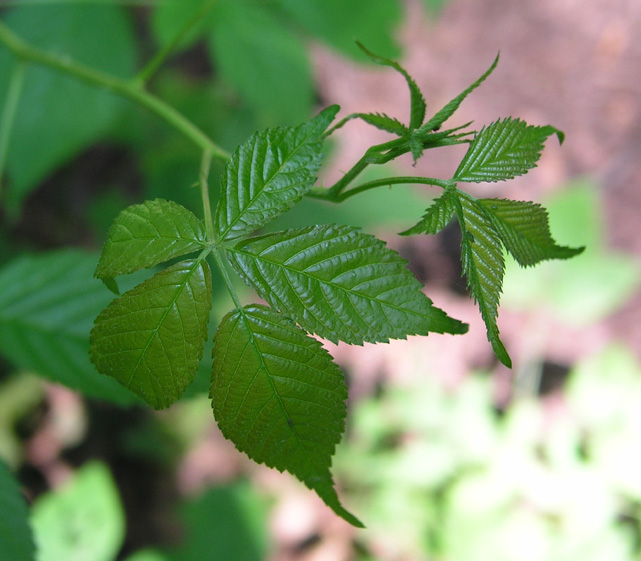 Complete Geographic Distribution: Native to Nebraska, Kansas, Oklahoma, and every state east, except for Louisiana, Mississippi, and Florida. R. allegheniensis is also native to California and north to the Canadian provinces of Quebec, Ontario, and British Columbia (14).
Complete Geographic Distribution: Native to Nebraska, Kansas, Oklahoma, and every state east, except for Louisiana, Mississippi, and Florida. R. allegheniensis is also native to California and north to the Canadian provinces of Quebec, Ontario, and British Columbia (14).
Vegetative Plant Description: The erect or arching stems are 0.5-3m tall and bear straight, perpendicular spines with a broad and flattened base. First-year stems are finely pubescent. The tip of the first-year stem is usually glandular. The branches of the second-year stems are stipitate-glandular and often “densely villous” (9). Second-year stems are brown-purple in color. The alternate leaves are palmately-compound with 3-7, but most often 5, leaflets per leaf. First-year leaves are usually 5-foliate and second-year are often trifoliate. The ovate to lanceolate-ovate leaflets are 3-15 cm long and 1-8 cm wide. The leaflets are widest at the middle and can be simply or doubly serrate with an acute to acuminate tip. The ovate-oblong to ovate terminal leaflet can be up to 20 cm long and 11 cm wide. It is widest at or below the middle and larger than the lateral leaflets on the same leaf. The leaflets are green on both sides. They can be glabrous to lightly pubescent above and soft-tomentose underneath. The stipitate-glandular petioles can be armed or unarmed. When armed, the spines are similar to the spines of the stem, but are hooked. Petiolules can be up to 7 cm long on terminal leaflets, shorter on the lateral leaflets. The petioles and petiolules are densely pubescent (1, 2, 4, 5, 6, 7, 9, 13).
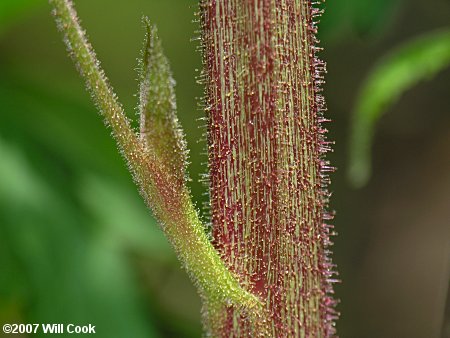 Climbing Mechanism: Rubus allegheniesis climbs as a scrambler, using its spines to anchor itself on supports as it ascends (personal observation, RJB).
Climbing Mechanism: Rubus allegheniesis climbs as a scrambler, using its spines to anchor itself on supports as it ascends (personal observation, RJB).
Flower Description: The perfect, 2.5-3.5cm broad flowers are borne in cylindrical racemes, 1-3 dm long and 2.5-5 cm wide. The lower 2 flowers, and sometimes the lower 3, are subtended by leaves. The others are subtended by stipule-like bracts. The stipitate-glandular pedicels are tomentulose and can be armed or unarmed. The persistent, 5-lobed calyx has acute, calyx lobes that are ovate to ovate-lanceolate. The 5 pubescent, stipitate-glandular sepals are 6-10 mm long with an acute to short-caudate tip. Each flower has 5 white petals, 1-2 cm long and 4-12 mm wide. Each petal has a distinctly cuneate base. There are many stamens and many superior carpels on a fleshy receptacle There are 2 ovules per carpel, one abortive (1, 2, 3, 4, 6, 7, 9).
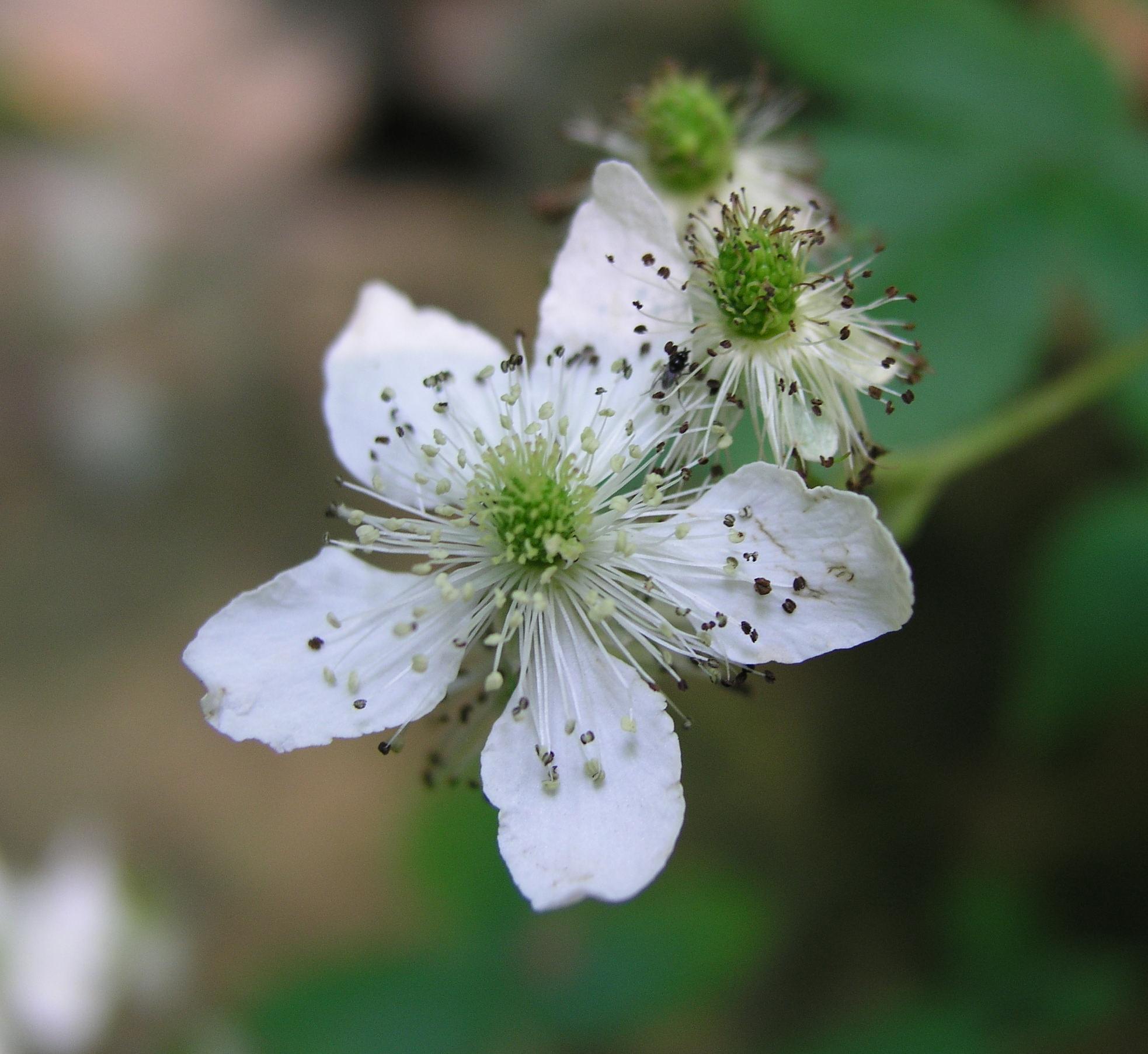 Flowering Time: In Michigan and the Great Plains, R. allegheniensis flowers in May and June (6, 7).
Flowering Time: In Michigan and the Great Plains, R. allegheniensis flowers in May and June (6, 7).
Pollinator: Insects pollinate the flower, although it is also able to reproduce by self-fertilization (6, 16).
Fruit Type and Description: The fruit of Rubus allegheniensis is a globose to elongate aggregate of drupes that is 1-2.5 cm long and 1.5-2.5 cm wide. The fruit is purple-black, although yellow fruit forms are known and have been seen in Michigan (in Branch county). The fruit does not separate from the receptacle when broken from the stalk (unlike raspberries). The fruit develops in July and August throughout North America and can still be developing into September in Michigan (1, 2, 3, 6, 11).
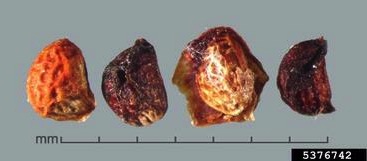 Seed Description: Each drupe has one “hard-pitted” (11) seed with almost no endosperm, a feature common to the genus Rubus. The 2.5-3 mm long seeds are yellow and have a rough surface (7).
Seed Description: Each drupe has one “hard-pitted” (11) seed with almost no endosperm, a feature common to the genus Rubus. The 2.5-3 mm long seeds are yellow and have a rough surface (7).
Dispersal Syndrome: The seeds are dispersed by birds and mammals (11).
Distinguished by: The petals of R. allegheniensis are longer than its sepals, whereas the opposite is true with Rubus occidentalis. The fruit of R. allegheniensis is a blackberry (the fruit separates with the receptacle) and the fruit of R. occidentalis is a raspberry (the fruit separates from the receptacle). R. allegheniensis has leaflets with a green underside, as opposed to the white undersides of R. occidentalis.
Rubus hispidus and Rubus flagellaris have ascending or trailing first-year stems that can root at the tips. The second-year stems are prostrate. This is opposed to the erect or ascending first and second-year stems of R. allegheniensis that do not root at the tips. R. allegheniensis is further distinguished from R. hispidus by its ovate to ovate-lanceolate leaflets. The leaflets of R. hispidus are obovate. R. hispidus also has spines that are narrow at the base, whereas R. allegheniensis has broad-based spines.
The unarmed stem and branches and pinnately arranged entire leaflets of Apios americana can be easily distinguished from the armed stem and branches, palmate and serrate leaves of R. allegheniensis. The stem of A. americana is also not erect or ascending, instead twining.
R. setigera has pink flowers that are very rarely white like the flowers of R. allegheniensis. Rosa multiflora usually has 7 pinnately arranged leaflets per leaf, as opposed to the 3 – 7 palmately arranged leaflets of R. allegheniensis. Rosa multiflora bears pinnatisect stipules, which distinguish it easily from R. allegheniensis
Other members of the family in Michigan: Rubus (48), Agrimony (5), Amelanchier (6), Argentina (1), Aruncus (1), Chamaerhodos (1), Comarum (1), Crataegus (42), Dalibarda (1), Dasiphorda (1), Duchesnea (1), Filipendula (1), Fragaria (2), Geum (9), Gillenia (2), Malus (4), Photinia (2), Physocarpus (2), Potentilla (11), Prunus (16), Pyrus (1), Rosa (18), Sanguisorba (3), Sibbaldiopsis (1), Sorbaria (1), Sorbus (3), Spiraea (6), Waldsteinia (1) (source 14)
Ethnobotanical Uses: The fruit can be eaten raw, cooked, or dried, as well produce a purple dye. The shoots are peeled and then used in salads, while an infusion of the roots can be used to treat stomach problems, coughs and colds, tuberculosis, and rheumatism. This infusion can also be used to wash out sore eyes (16). A tea can also be made from the leaves (8).
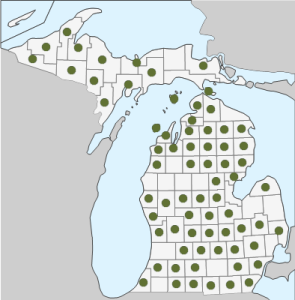 Phylogenetic Information: The genus Rubus is a member of the subfamily Rosoideae in the family Rosaceae. Rosoideae is distinguished by having many carpels and stamens, and an aggregate of achenes or drupes as fruits (18). Rosaceae dates back 76 million years and is within the order Rosales, which has been dated back 88-89 million years. Rosales is in the subclass Rosidae, a member of the eudicots (17).
Phylogenetic Information: The genus Rubus is a member of the subfamily Rosoideae in the family Rosaceae. Rosoideae is distinguished by having many carpels and stamens, and an aggregate of achenes or drupes as fruits (18). Rosaceae dates back 76 million years and is within the order Rosales, which has been dated back 88-89 million years. Rosales is in the subclass Rosidae, a member of the eudicots (17).
Interesting Quotation or Other Interesting Factoid not inserted above: This plant can grow in acidic, neutral, and alkaline soils (16). It is found as the most common shrub in a degraded, but still preserved, oak-savannas in the midwestern United States (20.)
Literature and websites used:
- Foote, L.E., and S.B. Jones Jr. 1989. Native Shrubs and Woody Vines of the Southeast: Landscaping Uses and Identification. Portland, Oregon, USA: Timber Press.
- Fernald, M. L. 1950. Gray’s Manual of Botany, 8th ed. New York, USA: American Book Company.
- Voss, E. G. 1985. Michigan Flora Part II: Dicots. Ann Arbor, Michigan, USA: Cranbrook Institute of Science.
- Gleason, H.A. 1963. The New Britton and Brown Illustrated Flora of the Northeastern United States and Adjacent Canada. New York, New York, USA: Hafner Publishing Co., Inc.
- Gleason, H.A. and A. Cronquist. 1991. Manual of Vascular Plants of the Northeastern United States and Adjacent Canada. Bronx, New York, USA: New York Botanical Garden Press.
- Barnes, B.V. and W.H. Wagner 1992. Michigan Trees: A guide to the trees of Michigan and the Great Lakes Region. Ann Arbor, MI, USA: The University of Michigan Press.
- McGregor R.L. 1986. Flora of the Great Plains. Lawrence, Kansas, USA: The University Press of Kansas.
- Weatherbee, E.E. and J.G. Bruce. 1982. Edible Wild Plants A Guide to Collecting and Cooking. 2nd ed. Ann Arbor, Michigan: Weatherbee and Bruce.
- Radford, A.E., H.E. Ahles, and C.R. Bell. 1968. Manual of the Vascular Flora of the Carolinas. Chapel Hill, North Carolina, USA: The University of North Carolina Press.
- Brown, R. W. 1956. Composition of Scientific Words. Washington, D.C., USA: Smithsonian Institution Press.
- Young, J.A. and C.G. Young. 1992. Seeds of Woody Plants in North America. Portland, Oregon, USA: Dioscorides Press.
- Stupka, A. 1964. Trees, Shrubs, and Woody Vines of Great Smoky Mountains National Park. Knoxville, Tennessee, USA: The University of Tennessee Press.
- Braun, E. Lucy. 1967. The Woody Plants of Ohio: Trees, shrubs, and woody climbers, native, naturalized, and escaped. Columbus, Ohio, USA; The Ohio State University Press.
- USDA, NRCS. 2009. The PLANTS Database (April 6th 2009). http://plants.usda.gov/java/profile?symbol=RUAL
- Jenkins, W.R. and M.A. Ayres. 1951. The Mountain Grass Communities of the Region of Mountain Lake, Virginia. Castanea 16(3) Sep., 1951: 92-96.
- Plants For A Future, 1996-2008. http://www.pfaf.org/database/plants.php?Rubus+allegheniensis
- Stevens, P.F. Angiosperm Phylogeny Website. Version 9, June 2008. http://www.mobot.org/mobot/research/apweb/
- Zomlefer, W.B. 1994. Guide to Flowering Plant Families. Chapel Hill, North Carolina, USA: The University of North Carolina.
- The International Plant Names Index. http://www.ipni.org/index.html
- Bowles, ML, and J.L. McBride 1998. Vegetation composition, structure, and chronological change in a decadent midwestern North American savanna remnant. Natural Areas Journal Vol. 18(1): 14-27
- Tropicos.org. Missouri Botanical Garden. 02 Jan 2013 http://www.tropicos.org/Name/27801178
Image Credits (all used with permission):
1) Image of the fruit is courtesy of Steven J. Baskauf from Vanderbilt University and Bioimages http://www.cas.vanderbilt.edu/bioimages/species/rual.htm
2) Image of the leaf is courtesy of George P. Chamuris at Bloomburg University of Pennsylvania http://departments.bloomu.edu/biology/Ricketts/Rubus/R_alle/r_alle.html
3) Image of stem glands is from Will Cook at Duke University http://www.duke.edu/~cwcook/trees/rual.html
4) Image of the flower is courtesy of George P. Chamuris at Bloomburg University of Pennsylvania http://departments.bloomu.edu/biology/Ricketts/Rubus/R_alle/r_alle.html
5) Image of the seeds is courtesy of Julia Scher, USDA APHIS PPQ, Bugwood.org http://www.forestryimages.org/search/action.cfm?q=rubus%20allegheniensis
6) Species distribution map, derived from the Michigan Flora Online.
Primary Authors: Dave Morris with edits and additions by John Bradtke and Robyn J. Burnham
© Robyn J. Burnham, University of Michigan
For additional information on Michigan Plant Diversity web pages please contact Robyn J. Burnham via email: rburnham“at”umich.edu